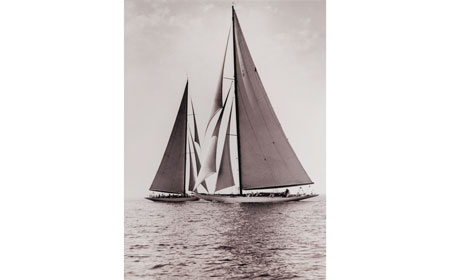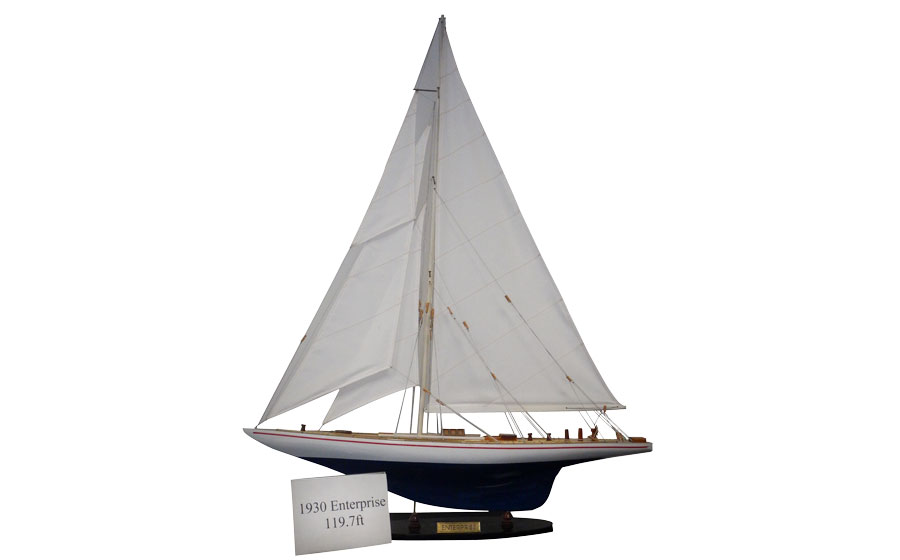History
In 1929 Sir Thomas Lipton issued a challenge to the Americans for the America's Cup. It was his fifth challenge and signified a whole new era in design evolution and racing. The late 1920s and 1930s also heralded the beginning of an age when yachts from both sides of the Atlantic were being raced under the same rule — the American Universal Rule. Previously, British yachts had raced under the International Rule, a rule that gave an advantage to bermudan rigged yachts, but which was restrictive for boats bigger than 48ft (141—2m). The Americans wanted to race bigger boats and so introduced the Universal Rule. It was based on ideas proposed by Nat Herreshoff and meant waterline length could be increased without sail area being restricted, as it had been under the International Rule. This was compensated by a larger displacement and draught was limited to 15ft (4.6m). The J-Class were the foremost designs under this rule.
Under the International Rule, yachts were very similar in specification, but under the Universal Rule they differed considerably. Several existing yachts, Astra, Candida, White Heather II and Britannia, were converted to comply with the rule and raced alongside the Js. They cannot, however, be classed as true Js. Of the true J-Class, only ten were ever built and these raced together for just eight seasons from 1930 to 1937. The rules for the J-Class stipulated that length overall had to exceed 120ft; LWL had to be between 79 and 87ft (36.6 x 24-26.5m) and they could displace up to 160 tons.
In answer to Lipton's challenge of 1929 the Americans designed four J-Class yachts as possible defenders. Enterprise, Whirlwind, Yankee and Weetamoe were launched within a month of each other; Weetamoe and Enterprise from the Herreshoff yard and Yankee and Whirlwind from Lawley & Son's yard in Bristol.
Enterprise was the first launched on 14 April 1930 and was later chosen as the Cup defender. At 80ft (24.4m) LWL she was shortest of the four US Js and conventional in all aspects. Designed by W Starling Burgess, she had lightweight rigging and was the fastest of the four to windward in moderate airs.
Whirlwind, the second J launched 16 days later, was the most revolutionary of the four. Francis L Herreshoff had moved away from conventional yachts and designed a boat which took the new rule to its extremes. Whirlwind combined many new ideas and Herreshoff experimented with hull shape and rig. She was the longest of the early Js at 86ft (26m) on the waterline and remained so until Ranger and Endeavour II were built in 1937. She was built of semi-composite construction (the other three American Js were built out of the highly expensive tobin bronze), was double-ended and had a permanent backstay. Uffa Fox described her profile as: "Very pleasing to the eye, the stem sweeping down to the keel in a very sweet line, and to a man who, like myself, believes that a pointed stern is a logical ending for all vessels, her stern is a joy to behold." He predicted "If the Yacht Racing Rules govern well and wisely, we shall see Whirlwind racing 50 years hence. If they do not she will probably be cruising then." But Whirlwind met an early demise. Her building was delayed as she didn't meet Lloyd's A1 scantling rules and she wasn't chosen to be the 1930s defender. She was often out-performed when close hauled, her steering gear making her difficult to steer. She was eventually scrapped along with Enterprise in 1935. However, her unusual double headsail rig was later adopted by the rest of the Js.
The third American J, Yankee, was the best all-rounder. At 84ft on the waterline and 125ft (25.6 x 38m) length overall, she was solidly made of tobin bronze and was extremely well balanced. Designed by Frank Paine, Yankee had an almost straight sheerline and easy lines. She was a powerful contender for defender, but not fine tuned enough to succeed. She did, however, take part in the 1934 America's Cup trials and with alterations to her rig, to carry more sail, and bow, which was lengthened and made more of a V-shape, she then proved more successful, especially in light winds.
Of the American Js, Yankee was the only one to sail in British waters when she was bought by Gerald Lambert and crossed the Atlantic in 1935. She was scrapped in 1941.
The fourth of the American Js was Weetamoe, which was designed by Clinton Crane and was the narrowest of the early four. Despite claims that Yankee was the best all-rounder, Weetamoe is said to have been the closest rival to Enterprise to be the Cup defender. Charles Nedwick, in Ian Dear's book Enterprise to Endeavour, describes Weetamoe as having a profile "that is practically a triangle, with a straight line from the after end of the waterline to the bottom of the keel and thence a line which is slightly convex, and then slightly concave to the forward end of the waterline." In an attempt to better performance and make her less tender, her profile below the water was radically altered in 1934 with a new contour and bulb keel. The alterations failed and not long afterwards were reversed. In common with the other Js, she had about 43ft (13m) of overhang and her hull, Nicholson opined, "was the best of all the US Js".
1930
In August Enterprise qualified for the
America’s Cup racing off Mattapoisett Massachusetts by defeating rival yachts
Yankee, Whirlwind and Weetamoe.
The Americans had a distinct advantage over Britain in the 1930 America's Cup. They had the money to build four Js over Britain's one, yet Shamrock V was a hot contender. She was designed by Nicholson and built at the family yard in 1930, and before she crossed the Atlantic to attend the Cup she had notched up more than 700 sea miles (1,296km), won 15 out of the 22 races she had entered and had been tweaked and tested to a high degree. When Shamrock V and Enterprise eventually met off Newport, Rhode Island, later that year, the two Js were well matched in hull profile, but differed significantly in rig. Enterprise's rigging was lighter, she had the Park Avenue boom, which was so advantageous to windward, and had lots of winches on board. Shamrock V meanwhile, was under-winched and hard work to sail. She has since, however, proved her success in that she is still sailing today.
Enterprise, winner of the 14th America’s Cup, in 1930, crushing Shamrock 4-0.
Just after the America's Cup races, Enterprise was dry-docked. It would never sail again.
1935
Broken up for scrap.
Source:www.classicboat.co.uk 7/2/2007
Boat
Cup(s) Sailed: 1930 (won)
Crew: 31
Owners: Winthrop W. Aldrich, Harold S. Vanderbilt, and Vincent Astor
Year Built: 1930
Launched: April 14, 1930
Type: Keel Sloop, fitted with two centerboards
Designer: William Starling Burgess
Builder: Herreshoff Manufacturing Company
Construction
Frames: Steel
Planking Top: Steel — Supplied by Lukens
Planking Bottom: Tobin Bronze
Deck: Pine
Mast: Aluminum
Boom: Wood
Spinnaker Pole: Wood
Keel Ballast: Lead
Dimensions
Length Overall: 119.7 ft. / 36.49 m
Length Waterline: 80.0 ft. / 24.38 m
Beam: 22.1 ft. / 6.73 m
Draft: 14.5 ft. / 4.42 m
Draft with Keel Lowered: N/A
Displacement: 127.6 tons
Tonnage: N⁄A
Sail Area: 2,311.5 sq. ft. / 704.48 sq. m
Mast: 150.8 ft. / 45.97 m
Boom: 78.8 ft. / 24.01 m
Bowsprit: N/A
Top Mast: N/A
Source:www.americascup.com
7/2/2007



